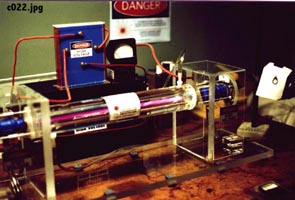
Désolé: pas de version française ! (Mais astronomie et construction à SCIENCES POUR TOUS http://spt06.chez.tiscali.fr/home.htm uniquement en français)
New: Build a low cost 40W continuous blue laser
Many well-equipped amateurs has realized various laser configuration: HeNe, Ar/Kr ion, CO2, N2, HeHg, CuCl/CuBr, Dye...
A laser is a coherent monochromatic light generated in a cavity fill with a material (solid, liquid or gas). This material receives external energy (light, electricity, laser..) which changes electrons orbit of atom's material, when electrons return to initial state, they emit light. If two mirrors are properly disposed in // on the two ends of cavity, this light is amplificated and a laser effect can occur.
Helium-Neon laser : a glass tube (l~10 cm to ~1 m x d~2 mm) fill with mixture of Helium and Neon (at low pressure) with a pair of mirrors at the ends: one reflective mirror and one partially reflective. 2 electrodes (near each end) with high tension (less than 4 kV). Tension makes Helium ionisation which transfers energy to Neon atoms, if mirrors are //, laser occurs and a red 632.8 nm (colors such infra-red, orange yellow, green is possible with proper optics) continuous few miliWatts beam output from partially reflective mirror.
Argon/Krypton ion laser : a glass tube (capillary) fill with mixture of Argon and Krypton with a pair of mirrors at the end: one reflective mirror and one partially reflective. 2 electrodes (near each end) with tension ~kV. When laser occurs, many spectral lines come in visible and UV spectrum. Commercial products using ~100 V ~10 A power are made with a ceramic bore capillary tubes to prevent meltdown. Due to the high power, strong air cooling or water cooling is then necessary.
C02 laser : a glass tube (~1m x d~20mm) fill with C02 (4.5% CO2, 13.5% N, 82% He at low pressure) with a pair of mirrors at the end: one special reflective mirror (~Silicon coated with Silver or Gold) and one special partially reflective (Germanium or Zinc selenide). 2 electrodes (near each end) with high tension ~15 kV... If mirrors are //, laser occurs and a mid infrared 10.6 um continuous ~few Watts beam output form partially reflective mirror. CAUTION : CO2 laser efficiency is very high : near 20% and very high power : over 10 Watts for amateur and much much more for commercial system, is possible with an infra red absolutely invisible beam : CO2 laser can be very dangerous. At 10.6 um, most material are opaque and optical parts to focus beam are very special.

N2 laser : a laser without glass and mirrors! (a laser at normal air pressure can even be done: Build a 10$ air laser ) a plastic box fill with low pressure N2 with 2 linear electrodes, 2 glasses : one at each end, high tension capacitors and a self. Capacitors are charging, when tension is high enough, an electric arc occurs between an adjustable screw and ground : a brief ~5ns high tension difference appears between the 2 electrodes and a few ns short laser pulse in the UV 337.1 nm outputs at each end, N2 Laser project
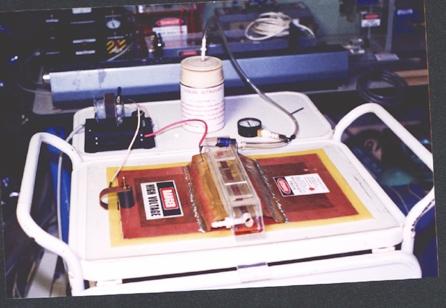
Helium-Mercury laser : a glass tube (~120cm x d~10mm) fill Helium (at low pressure) and Mercury vapours with a pair of mirrors at the end : one reflective mirror and one partially reflective. 2 electrodes near each ends with pulsed power high tension ~5 kV rapid discharge... If mirrors are //, laser occurs and a red-orange 615 nm and a green 567 nm continuous few miliWatts beam output from partially reflective mirror.
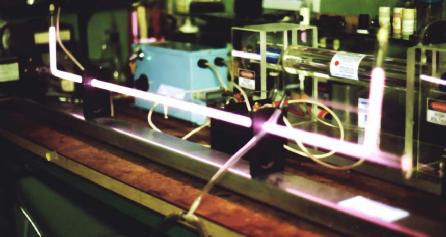
Copper laser : A quartz tube with copper chloride (CuCl) and/or copper bromide (CuBr) is warmed in an oven at about 400°C. A high tension power with high energy capacitors is discharged in the tube (150 us between first discharge to separate copper atoms form halide and second discharge to excite free copper atoms). Green (510.6 nm) and yellow (578.2 nm) intense pulses outputs. Perhaps the easiest visible laser to realize for an amateur.
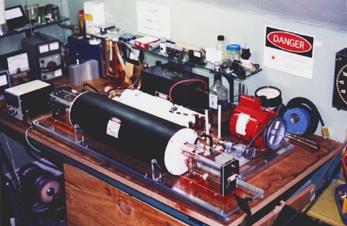
Dye laser : a little tube with mirrors is filled with Dye (Rhodamine-B...) and pure alcohol, 2 electrodes and low air pressure form a flash lamp to pump Dye (or a commercial Xenon lamp with special high voltage circuitry and spark-gap triggered capacitor). When flash light occurs, laser pulses appear generally in the visible spectrum, depending which Dye is used.
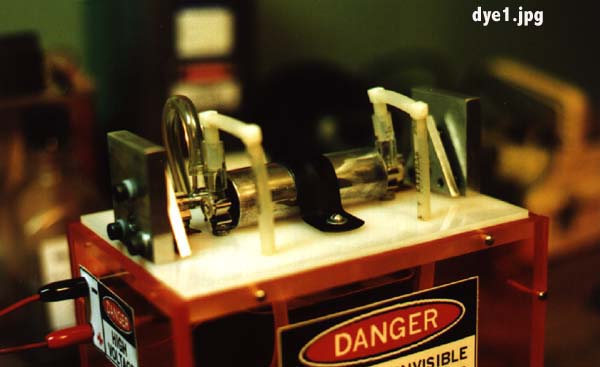
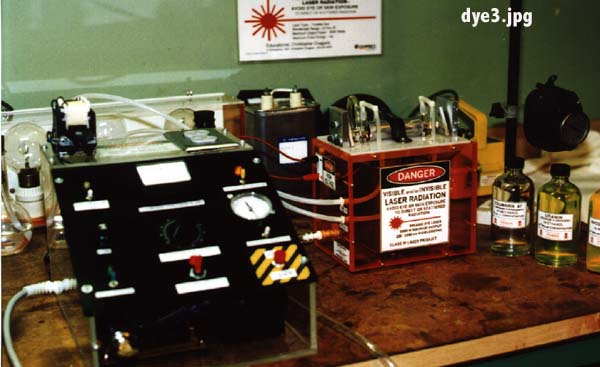
Semiconductor laser : realization not (today) for amateur: a little semiconductor crystal receives current (~~100mA, ~2.2V), it emits light like Led. Due to the special configuration and because 2 sides of the cristal acts as mirrors, continuous laser occurs and a divergent beam (~20°) is emitted on each side. Generally, a monitor photodiode is disposed on one side to control the optical power. All that is installed in a little package. Today laser diodes are available from far infrared to red (635 nm) blue and near UV area (400 nm). Laser diodes wavelength less than red 635 nm are expensive but prices drop very quickly. CD laser uses 780 nm (near infrared, still visible) diodes. Laser diode is today the far more cheapest way to get a laser beam: we find (even in supermakets) red laser pointers complete with batteries for less than $20.
Ruby laser : A synthetic saphir (AL2O3) with chromium (Cr3+) (~10cm x d=~1cm) and 2 mirrors at each end is disposed at the focal axis of a highly reflective ellipse hole. On the other focal, a high energy pulse lamp, when excited, pumps atoms and a high energy red laser light pulse output from the partially reflective mirror. This has been the first laser invented by Maiman in 1960.
Yttrium (YAG) laser : A synthetic Garnet crystal (~10cm x d~1cm) of Yttrium and Aluminum (Y3Al5012 doped with a small percentage ~1% of Neodymium ) and 2 mirrors at each end is disposed at the focal axis of a highly reflective ellipse hole. On the other focal, a high energy pulse lamp, when excited, pumps Neodynium atoms and a high energy light (near infrared 1064 nm) pulse outputs from the partially reflective mirror. The same device, without mirrors, can be used to amplify a pulse.
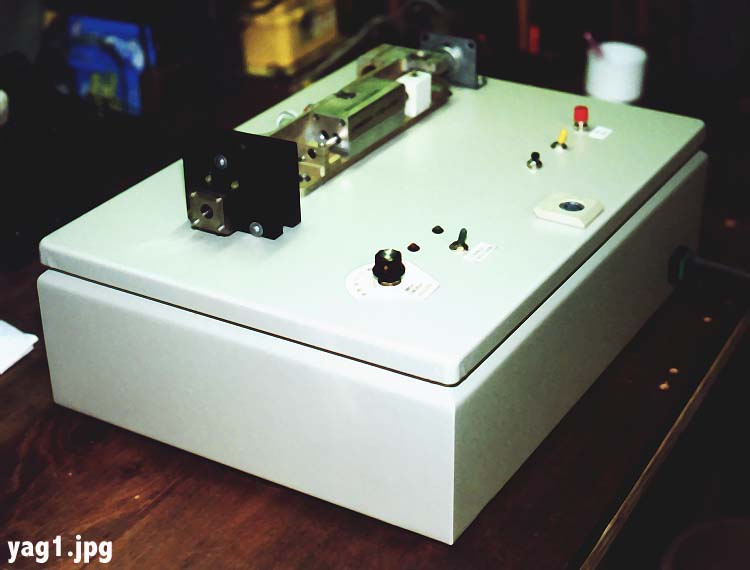
Also Excimer laser, chemical laser, parametric laser...
Thanks to Chris Chagaris (pyro@grolen.com) for help and photos.
E-mail :

25/10/13.